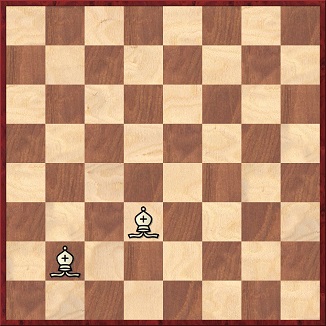
Edward Winter

Horrwitz, Horwitz, Harrwitz, Horowitz ...?
As noted by W.H. Cozens on page 402 of the September 1978 BCM (in connection with The Encyclopedia of Chess by H. Golombek), chess reference books do not agree on whether raking bishops should be named after Harrwitz or Horwitz. A detailed article on the subject, by Peter Gütler, is on pages 42-43 of Kaissiber, April-June 1999.
To add a further complication, we would point out that another nineteenth-century figure whose name has been connected with the bishop pair is Louis Paulsen. The passage hereunder comes from page 73 of the November 1882 Chess Monthly, in the annotations to the game Blackburne v L. Paulsen, Vienna, 1882:
‘Herr Paulsen conducts the endgame with great vigour and rare accuracy. “Paulsen’s bishops” tell once more!’
At one stage in the game Paulsen’s bishops were indeed ‘raking’ (i.e. on b7 and b6, as well as b6 and a6), but it is unclear whether the term ‘Paulsen’s bishops’ was, in this case, being used merely as a general reference to the pair of prelates.
We wonder too when exactly Janowsky’s dexterity gave rise to the term ‘the two Jans’.
(2593)
‘There is no finer combination recorded than the one by which, in his last game with Kolisch, he won the exchange. The conception is magnificent.’
This remark, referring to Louis Paulsen, comes from the Bristol Daily Post, and was quoted on page 318 of the Chess Player’s Chronicle, 1861. The game in question is evidently the Kolisch v Paulsen brilliancy played in Bristol on 14 September 1861 and given on pages 314-315 of the same issue of the Chronicle. Readers will have little difficulty in finding the game (in which Black exploits his bishop pair with, in particular, a very unusual type of move for the nineteenth century: 19…c3). It may, however, be noted that page 177 of Faszinierendes Schach by I. Linder (East Berlin, 1986) wrongly stated a) that the venue was London, and b) that, rather than resigning, White played on to the bitter end with 29 Qb2 Qxb2 30 Bxb2 Nxf4 31 Nxf4 Nf2 mate.
(2625)
A footnote on page 363 of A Chess Omnibus pointed out that on page 156 of his Encyclopedia Golombek asserted that ‘the Americans, during his stay in the USA, referred to them as “the two Jans”.’
The verb ‘to rake’ has long been used in connection with the bishop’s move. For instance, page 258 of Staunton’s London, 1851 tournament book referred to a bishop ‘raking almost the whole diagonal up to the adversary’s KR’s sq.’
Concerning ‘the two Jans’, a number of reference works (see, for instance, the entries on Janowsky in the Dictionnaire des échecs, the hardback edition of Golombek’s Encyclopedia of Chess and the 1984 edition of the Oxford Companion to Chess) affirm that this was a common term in the United States to describe a bishop pair. An extract from page 206 of the Dictionnaire des échecs by F. Le Lionnais and E. Maget (Paris, 1967):
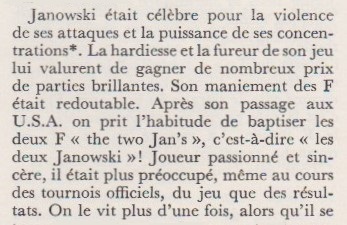
We have yet to trace the term in chess literature during Janowsky’s lifetime.
After presenting some victories by Janowsky [against Trenchard, Ettlinger, N.N. and Alapin] C.N. 351 commented:
... such games offer little support to the theory that Janowsky was obsessed with retention of the bishop pair. On the other hand, on page 330 of the October-November 1904 issue [of the Wiener Schachzeitung] Tarrasch, annotating the Cambridge Springs game Mieses v Janowsky remarks: ‘Janowski ist einer der wenigen Spieler, die das Geheimnis der Läufer begriffen haben und die latente Kraft dieser Figuren herauszuholen verstehen’.
(9656)
Some general comments on the relative strength of bishops and knights were made by Janowsky when annotating his win over Napier at Hanover, 1902. After Black’s 42nd move he wrote:
‘The two knights have been completely immobilized. The superiority of two bishops against two knights is demonstrated once again in striking form. This matter has been discussed in the chess press very frequently; some (Dr Tarrasch, for example) prefer the two bishops while others (Mr Chigorin) prefer the two knights. Some theoreticians have declared that everything depends on the position; that does not settle the issue since when a result depends on the position the superiority or inferiority of the two bishops is not demonstrated at all. In my opinion, having two bishops against two knights in a more or less equal position is a significant advantage.’
Source: La Stratégie, 17 September 1902, page 283.
(2501)
Also from Janowsky Jottings:
Ossip Bernstein gave the following assessment on page 15 of the January 1956 Chess Review:
‘Janowsky was no chess scientist or theoretician. He knew what he had to do on the chessboard; but he did not know, or could not explain, why it had to be done. He had only two rules in chess: always attack; always get the two bishops (and, indeed, he used the advantage of the two bishops wonderfully). His main strength, indeed, was his extraordinary intuition, which gave him the exact feeling for what to do and how to do it.’
The didactic value of Janowsky’s handling of the bishop pair was also stressed by Alekhine. Writing in 1945, he noted that the prodigy Arturo Pomar had not yet learned the value of the two bishops and advised that ‘it would be very profitable for him to study the best games of Janowsky’. (Source: ¡Legado! by Alekhine, page 125.)
A consultation game in which Dawid Janowsky (White) faced Frank J. Marshall shows the former’s liking for the bishop pair:
1 e4 e5 2 d4 exd4 3 c3 dxc3 4 Bc4 cxb2 5 Bxb2 Nf6 6 Nf3 d5 7 exd5 Bb4+ 8 Nc3 Qe7+ 9 Be2 Ne4 10 Rc1 O-O 11 O-O Nxc3
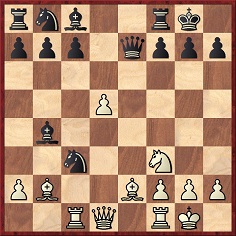
12 Rxc3 Bxc3 13 Bxc3 Nd7 14 Re1 Nf6 15 Bd3 Qd8 16 Re5 Re8 17 Rg5 h6 18 Rg3 Nh5 19 Bc2 Nxg3 20 hxg3 f5 21 g4 Re4
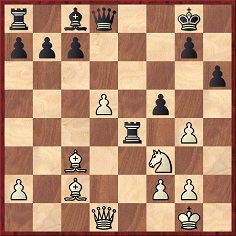
22 Ne5 Qg5 23 d6 cxd6 24 Qxd6 Qc1+ 25 Bd1 Rxe5 26 Bxe5 Kh7 27 Kh2 Be6 Drawn.
The game, played at the Automobile Club de France in Paris in October 1907, was published on pages 386-387 of La Stratégie, 20 November 1907 with Janowsky’s notes from Le Monde Illustré. Those annotations were the basis for what appeared on pages 289-290 of Voronkov and Plisetsky’s book on Janowsky (Moscow, 1987) and on pages 472-474 of Ackermann’s monograph (Ludwigshafen, 2005).
La Stratégie stated that Janowsky was partnered by Bonaparte Wyse, and Marshall by le baron de Laforie, although the annual index (page 454) gave le comte de Laforie. In the Soviet and German books the name was, respectively, Лафори and Lafore.
(9704)
See too The Double Bishop Sacrifice.
From a game won by V. Place (against ‘N.L.’) at the Café de la Régence, Paris in January 1922 (given in The Chess Seesaw):
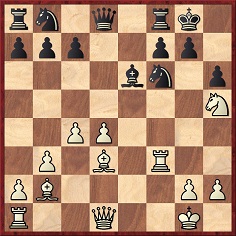
1 Nxg7 Kxg7 2 d5 Bg4 3 Rxf6 Bxd1 4 Rg6+ Kh7 5 Rg7+ Kh8 6 Rh7+ Kg8 7 Rh8 mate.
Source: La Stratégie, May 1922, page 113.
(2838)
As mentioned in C.N. 2593 (see also page 363 of A Chess Omnibus), a detailed article on the hoary subject of Horrwitz/Horwitz/Harrwitz bishops (and it is, of course, even possible to find the term ‘Horowitz bishops’) was written by Peter Gütler on pages 42-43 of the 2/1999 issue of Kaissiber.
(7278)
Addition on 9 November 2024:
Over 25 years after publication, Peter Gütler’s article Die Horrwitz-Läufer remains valuable as a guide to what Nimzowitsch wrote in My System. Below we offer a summary (with numbers corresponding to the paragraphs in Kaissiber):
1. In Nimzowitsch’s Mein System ‘Horrwitz bishops’ occurs twice, and the Oxford Companion to Chess (1992) says, ‘No one knows whether he meant Horwitz, Harrwitz, or someone else’. Various, though not all, later editions of Mein System in German and English put ‘Horwitz’. The question is who inspired the term or whether Nimzowitsch coined it himself when he wrote:
2. ‘The Horrwitz bishops: Two bishops when they rake two neighbouring diagonals (e.g. BQKt2, BQ3), and thus united bombard the enemy king’s position, are sometimes called the Horrwitz bishops.’ [Text on page 202 of the first edition of My System (London, 1929)]
3. Nimzowitsch’s use of the phrase ‘are sometimes called’ suggests that the term came from elsewhere. Nimzowitsch was not wont to write a person’s name in a technical term.
4. Nimzowitsch would not be expected to leave readers in the dark over the origin of the ‘Horrwitz bishops’.
5. The only relevant source mentioned by Nimzowitsch (once) is Berger’s Theorie und Praxis der Endspiele. Nimzowitsch wrote that the bishop pair is not part of his System, but a type of weapon and classified as such by Berger.
6. Berger’s book has no mention of ‘Horrwitz bishops’, but does have a composition by Horwitz (see below) which is relevant, except that a pawn is shielding the king, and it is not an attack on a castled king as in Mein System.
White to move and win
B. Horwitz, Chess Monthly, October 1883, page 637. That passage by Berger seems to have resulted in Nimzowitsch, a chess master and not a scholar, using the the term ‘Horrwitz bishops’ under the misapprehension that it had been coined by Berger.
8. Nimzowitsch’s later book Die Praxis meines Systems did not use the term, despite having positions with ‘Horrwitz bishops’. Nimzowitsch had probably noticed his error and discreetly dropped the term.
9. It is unclear whether Nimzowitsch wrote ‘Horrwitz’ instead of ‘Horwitz’. The original edition of Mein System had hundreds of printing errors, and only an examination of the manuscript, if it still exists, could show how the ‘Horrwitz’ mistake arose.
10. There has been no author named ‘Horrwitz’. Daniel Harrwitz could not have inspired the term, because his only book – Lehrbuch des Schachspiels (1862) – did not discuss the bishop pair.
The conclusion seems plain enough: Nimzowitsch’s reference to ‘Horrwitz’ should be to ‘Horwitz’.
To the Archives
for other feature articles.
Copyright Edward Winter. All rights reserved.